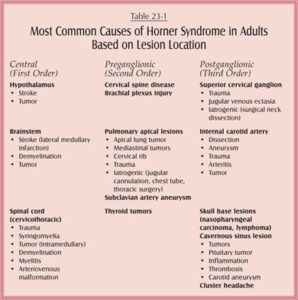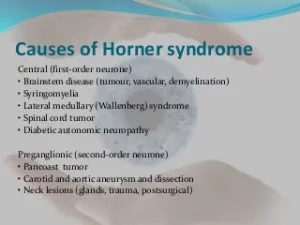Signs and Symptoms:
Horner syndrome is a relatively rare disorder characterized by a constricted pupil (miosis), drooping of the upper eyelid (ptosis), absence of sweating of the face (anhidrosis), and sinking of the eyeball into the bony cavity that protects the eye (enophthalmos). These are the four classic signs of the disorder.
The congenital, and more rare, form of Horner syndrome is present at birth but the cause is not known. Most often, Horner syndrome is acquired as a result of some kind of interference with the sympathetic nerves serving the eyes. The underlying causes can vary enormously, from a snake or insect bite to a neck trauma made by a blunt instrument.
The characteristic physical signs and symptoms associated with Horner syndrome usually affect only one side of the face (unilateral). These include drooping upper eyelid; contracted pupil; dryness (lack of sweating) on the same side of the face (ipsilateral) as the affected eye; and retraction of the eyeball.
If the onset of Horner syndrome is before two years of age, the colored portions of the eyes (irises) may be different colors (heterochromia iridis). In most cases, the iris of the affected side lacks color (hypopigmentation).
Causes:
-In most cases, the physical findings or symptoms are associated with Horner syndrome develop due to an interruption of the sympathetic nerve supply to the eye due to a lesion or growth. The lesion develops somewhere along the path from the eye to the region of the brain that controls the sympathetic nervous system (hypothalamus). The sympathetic nervous system (in conjunction with the parasympathetic nervous system) controls many of the involuntary functions of glands, organs, and other parts of the body.
-carotid artery dissection
–the development of a tumors which can be in the neck or chest cavity particularly a neuroblastoma and a tumor of the upper part of the lung (Pancoast tumor); the development of a lesion in midbrain, brain stem, upper spinal cord, neck, or eye orbit; inflammation or growths affecting the lymph nodes of the neck; and/or surgery or other forms of trauma to the neck or upper spinal cord.
Risk Factors:
Horner syndrome may result from any one of a variety of factors!
1. Some cases of Horner syndrome it occurs for no apparent reason or unknown cause (idiopathically).
2. In other cases, it could be heridity.
What some clinical researchers have found, they believe the disorder may be inherited as an autosomal dominant genetic trait.
Chromosomes, which are present in the nucleus of human cells, carry the genetic information for each individual. Human body cells normally have 46 chromosomes. Pairs of human chromosomes are numbered from 1 through 22, and the sex chromosomes are designated X and Y. Males have one X and one Y chromosome, and females have two X chromosomes. Each chromosome has a short arm designated “p” and a long arm designated “q”. Chromosomes are further sub-divided into many bands that are numbered. For example, “chromosome 11p13” refers to band 13 on the short arm of chromosome 11. The numbered bands specify the location of the thousands of genes that are present on each chromosome.
Genetic diseases are determined by the combination of genes for a particular trait that are on the chromosomes received from the father and the mother.
All individuals carry a few abnormal genes. Parents who are close relatives (consanguineous) have a higher chance than unrelated parents to both carry the same abnormal gene, which increases the risk to have children with a recessive genetic disorder.
Dominant genetic disorders occur when only a single copy of an abnormal gene is necessary for the appearance of the disease. The abnormal gene can be inherited from either parent, or can be the result of a new mutation (gene change) in the affected individual. The risk of passing the abnormal gene from affected parent to offspring is 50% for each pregnancy regardless of the sex of the resulting child.

